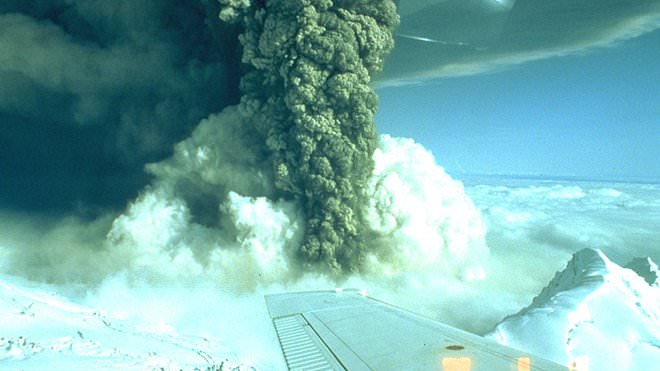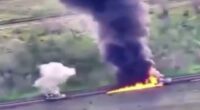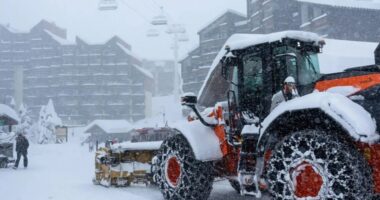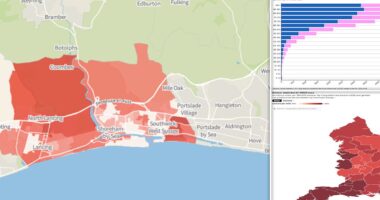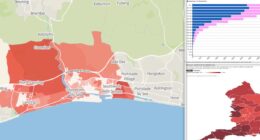Nearly 300,000 Americans remain on alert as Mount Spurr continues to show signs of volcanic unrest that began earlier this year.
The Alaska Volcano Observatory (AVO) stated that despite ongoing heightened seismic activity, they observed a decrease in earthquakes under Mount Spurr. In the last month, they recorded 60 to 80 earthquakes per week, a lower rate compared to the levels seen in January and February.
According to the AVO, the frequency of deep earthquakes occurring more than 6 miles below sea level has been relatively constant. This suggests that there is ongoing magma activity deep beneath the volcano.
While the AVO noted that ground deformation, which can indicate magma movement, has decelerated in the past three weeks, they have been unable to conduct volcanic gas measurements since March. This is due to persistent adverse weather conditions that have hindered monitoring flights.
‘The modest changes in monitoring data over the past month suggest the likelihood of an eruption has decreased,’ AVO noted, adding that the lack of recent gas measurements has made it more difficult to fully assess the volcano’s current state.
Despite the decline in surface activity, AVO emphasized that an eruption remains a possibility due to continued deep magma movement.
While Anchorage lies outside the immediate impact zone of Mount Spurr, previous eruptions in 1953 and 1992 sent ash clouds over the city, coating it in about a quarter inch of ash.
A similar event today could result in widespread ashfall across the region, the AVO warned.

While Anchorage lies outside the immediate impact zone of Mount Spurr, previous eruptions in 1953 and 1992 (pictured) sent ash clouds over the city, coating it in roughly a quarter inch of volcanic ash

A similar event today could result in widespread ashfall across Anchorage, which is home to nearly 300,000 people (pictured)
Mount Spurr began exhibited three key signs of a forthcoming eruption earlier this year: increased seismic activity, swelling of the volcano’s surface and snow and ice melt near the summit due.
While ground deformation has dramatically slowed, AVO highlighted that it happened in Fall 2024 before picking up again.
‘Collapse of snow and ice into the summit crater lake that formed during this period of unrest continues, along with steam emissions from fumaroles within and around the summit crater,’ Thursday’s update reads.
‘There have been no significant changes to the fumaroles within Crater Peak over the past month.’
Fluctuation rates of earthquakes has also occurred during past unrest periods, for example before the eruption of Redoubt Volcano in 2009.
The volcano, located on on the west side of Cook Inlet, saw seismic activity dip in September 2008, but pick back up just three days before it erupted on March 23, 2009.
‘We cannot assign an exact timeframe for when an eruption will occur, if it does,’ the AVO said.
‘We expect to see additional changes to monitoring data prior to an eruption, as magma moves closer to the surface.’

Mount Spurr began exhibited three key signs of a forthcoming eruption earlier this year: increased seismic activity, swelling of the volcano’s surface and snow and ice melt near the summit due. Pictured is Mount Spurr releasing gas on March 26
While the likelihood of an eruption without additional warning is currently low, the volcano poses hazards for recreators on Mount Spurr.
That is due to elevated carbon and sulfur dioxide levels in low-lying areas around or downwind of the gas vents, such as within the craters atop Crater Peak and Spurr summit. The AVO noted this is not present in local communities.
The eruption would most likely occur at the Crater Peak side vent, and ‘it would be explosive,’ Matt Haney, scientist-in-charge at the Alaska Volcano Observatory (AVO) at US Geological Survey (USGS) told DailyMail.com.
This event would spew multiple plumes of ash rising as high as 50,000 feet into the air, Haney said.
Each ash-producing explosive episode would last three to four hours, and the resulting cloud could blanket the city of Anchorage and other nearby communities in a thick layer of dust.
The eruption would also produce destructive mudslides and avalanches volcanic debris racing down the volcano’s side at over 200 miles per hour, ‘but fortunately, there are not any communities in that radius that would be affected,’ Haney said.
With memories of the 1992 eruption still fresh, locals are rushing to buy everything from tape to seal windows and doors, to goggles, earplugs, N95 masks and essential supplies like food and water.
Cloe Turner, a resident of Eagle River, spent $415 at Costco loading up on groceries, batteries, protective gear, and pet food.
‘We might not be able to work, and stores might not open,’ she said. ‘The last time something like this happened, the city was blanketed in ash for an entire month.’
